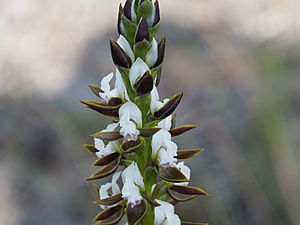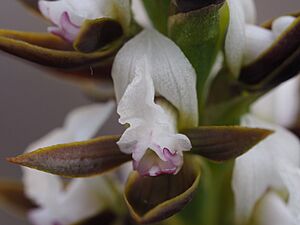Frilled leek orchid facts for kids
Quick facts for kids Frilled leek orchid |
|
|---|---|
 |
|
| Prasophyllum sargentii growing near Hopetoun | |
| Scientific classification | |
| Synonyms | |
|
Prasophyllum australe var. sargentii Nicholls |
The frilled leek orchid (scientific name: Prasophyllum sargentii) is a special type of orchid. It is found only in the south-west part of Western Australia. This means it is endemic to that area.
This orchid is quite tall. It has a single smooth, tube-shaped leaf. Its flowers can be purplish and white, or golden brown and white. They also have a unique, frilly part called a labellum.
Contents
What Does the Frilled Leek Orchid Look Like?
The frilled leek orchid is a plant that grows from an underground tuber (like a small potato). It is a perennial plant, meaning it lives for more than two years. It's also a deciduous plant, which means its leaves fall off at certain times.
Leaves and Stems
Each orchid has one smooth, green leaf that looks like a tube. This leaf can be about 150 to 250 millimeters (6 to 10 inches) long. It is about 4 to 10 millimeters (0.16 to 0.39 inches) wide near its base. The flowers grow on a tall stem called a flowering spike. This spike can be 200 to 600 millimeters (8 to 24 inches) tall.
Flowers
Each flowering spike can have between 10 and 35 or more flowers. The flowers are usually brownish and white. They are about 18 millimeters (0.71 inches) long and 9 to 11 millimeters (0.35 to 0.43 inches) wide. The petals of the flower point forwards. The side sepals (leaf-like parts that protect the flower) stand upright. They are white and joined together at their edges.
The most interesting part is the labellum. This is a special lip-like petal. It is white, sometimes with a pink tint, and has frilly edges. The labellum turns upwards towards the side sepals. These orchids usually bloom from August to October. They often flower after a bushfire or if the ground has been lightly disturbed.
Where Does the Frilled Leek Orchid Grow?
The frilled leek orchid likes to grow in sandy soil. You can find it in areas with shrubs (shrubland) and trees (woodland). As mentioned, it often flowers after a fire or some disturbance to the soil. This orchid is found across a wide area in Western Australia. It grows from Kalbarri in the north all the way to Israelite Bay in the east.
How is the Frilled Leek Orchid Protected?
The Western Australian Government's Department of Parks and Wildlife keeps an eye on plants like the frilled leek orchid. They have classified Prasophyllum sargentii as "not threatened." This means that, for now, there are enough of these orchids in the wild, and they are not in danger of disappearing.


